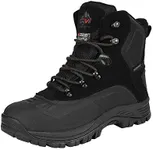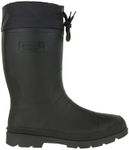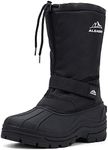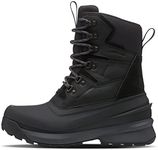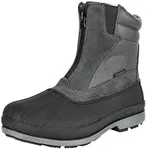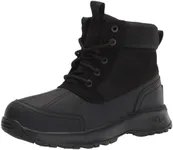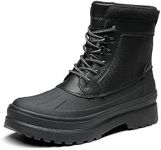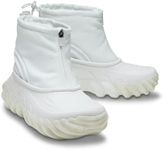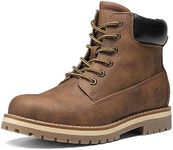Buying Guide for the Best Snow Boots For Men
Choosing the right snow boots for men involves considering various factors to ensure comfort, warmth, and functionality. Snow boots are essential for keeping your feet dry and warm in snowy and icy conditions. To make the best choice, you need to understand the key specifications and how they align with your needs and activities. Here are the main specs to consider when selecting snow boots for men.InsulationInsulation in snow boots is what keeps your feet warm in cold temperatures. It is usually made from materials like Thinsulate or synthetic fibers. The level of insulation is often measured in grams, with higher numbers indicating more warmth. For mild winter conditions, 200-400 grams of insulation may be sufficient. For colder climates or extended periods outdoors, look for boots with 600-800 grams or more. Consider your typical outdoor activities and the temperatures you will be facing to choose the right level of insulation.
WaterproofingWaterproofing is crucial for keeping your feet dry in wet and snowy conditions. Snow boots can be made from waterproof materials or treated with waterproof coatings. Look for boots with a waterproof membrane or seam-sealed construction to ensure no water seeps in. If you will be in deep snow or slushy conditions, prioritize boots with high waterproof ratings. For less extreme conditions, water-resistant boots may suffice.
TractionTraction refers to the grip of the boot's sole on slippery surfaces. Good traction is essential to prevent slips and falls on ice and snow. Look for boots with rubber outsoles that have deep lugs or treads designed for winter conditions. Some boots also feature specialized rubber compounds that remain flexible in cold temperatures. If you will be walking on icy paths or uneven terrain, prioritize boots with aggressive tread patterns and high-quality rubber soles.
Fit and ComfortFit and comfort are important for ensuring that you can wear your snow boots for extended periods without discomfort. Snow boots should fit snugly but not too tight, allowing room for thick socks. Consider boots with adjustable features like laces, straps, or drawcords to customize the fit. Pay attention to the boot's interior lining and cushioning, as these contribute to overall comfort. If you have specific foot issues, look for boots with additional support features.
HeightThe height of snow boots affects how well they protect against deep snow and cold. Boot height is measured from the sole to the top of the boot. Taller boots (10 inches or more) offer better protection against snow and are ideal for deep snow or snowshoeing. Mid-height boots (6-9 inches) provide a balance of protection and mobility, suitable for most winter activities. Shorter boots (under 6 inches) are easier to walk in but offer less protection, making them better for light snow or urban use.
WeightThe weight of snow boots can impact your mobility and comfort, especially if you will be wearing them for long periods. Heavier boots often provide more insulation and durability but can be cumbersome. Lighter boots are easier to walk in and can reduce fatigue, but they may offer less warmth and protection. Consider the trade-off between weight and functionality based on your activities. For long hikes or active use, lighter boots may be preferable, while heavier boots are better for extreme cold and deep snow.
Ease of UseEase of use refers to how easy it is to put on and take off the snow boots. Features like pull tabs, side zippers, or quick-lace systems can make the process more convenient. If you frequently need to remove your boots, look for designs that offer quick and easy access. This is particularly important if you will be transitioning between indoor and outdoor environments often.

